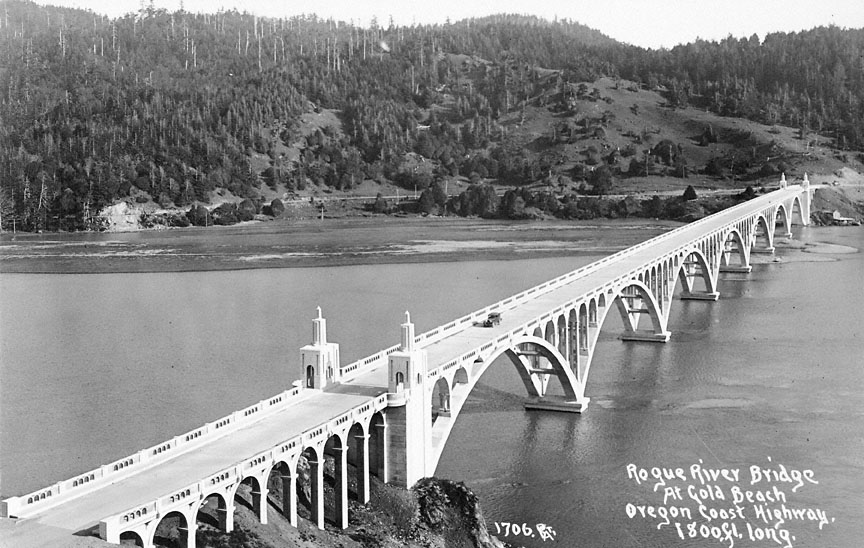- Catalog No. —
- OrHi 105404
- Date —
- 1931
- Era —
- 1921-1949 (Great Depression and World War II)
- Themes —
- Transportation and Communication
- Credits —
- Oregon Historical Society
- Regions —
- Coast Southwest
- Author —
- Unknown
Rogue River Bridge, Gold Beach
The Isaac Lee Patterson Bridge across the Rogue River on Highway 101 at Gold Beach is depicted above at the time of its completion in 1931; it was dedicated on May 28, 1932.
Through the end of the nineteenth century, the rugged Oregon coastline could be walked on a network of trails that paralleled the shore or followed the hard sand beaches, crossing the many coastal streams by ford, canoe, or ferry. There were few good ports on the coast, and regular ocean-going service did connect, for example, ports on Coos Bay and Yaquina Bay with San Francisco and Portland. But no service ever connected Coos Bay with other coastal points such as Tillamook or Reedsport. The establishment of a road the length of the coastline was not seriously pursued until the 1920s. Depression-era public works projects helped to push the completion of what was called the Roosevelt Highway in 1940.
The coastal highway was stitched together during the 1920s and 1930s, the most notable links being a series of bridges across the Wilson, Nehalem, Yaquina, Siuslaw, Umpqua, and Rogue Rivers as well as the Alsea River and Coos Bay estuaries. Most of the bridges were designed by Conde B. McCullough, an acclaimed engineer who was the head of the bridge section of the Oregon Department of Transportation from 1920 to 1935. These were structurally innovative reinforced concrete bridges that were esthetic landmarks as well as engineering marvels. McCullough himself, as quoted in the Coos Bay Times, once described his proposed series of bridges as “jeweled clasps in a wonderful string of matched pearls,” not just utilitarian traffic ways.
The Patterson bridge was the first in the United States to use the Freyssinet method of arch stress control, which led to the widespread use of prestressing techniques in erecting concrete arches, for the method also reduced construction costs. McCullough designed a graceful seven-arch bridge across the Rogue River that paid great attention to detail. Special concrete forms and careful smoothing and scoring of the flat surfaces of the concrete supplied the illusion that the arches and piers were of stone. A set of pylons emerged from the first set of piers at each end of the bridge, pierced by passageways for the sidewalks that were capped by obelisks. While his earlier bridge designs had used Classical Revival design elements, the later spans, such as the Patterson Bridge, adapted elements from the Art Deco and Streamline Moderne styles popular in the architecture and design fields. Aside from the Alsea Bay span, which suffered damage from corrosion and was replaced in 1989-1991, nearly all of the McCullough-designed bridges remain in active use.
Further Reading:
Smith, Dwight A., James B. Norman, and Pieter T. Tykman. Historic Highway Bridges of Oregon. Portland, Oreg., 1989.
Hadlow, Robert W. Elegant Arches, Soaring Spans: C. B. McCullough, Oregon’s Master Bridge Builder. Corvallis, Oreg., 2001.
Written by Richard Engeman, © Oregon Historical Society, 2005.
